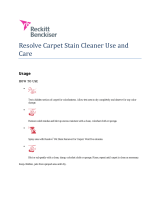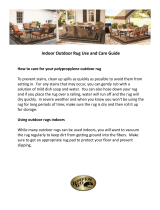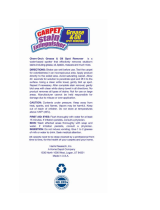Page is loading ...

Care and Cleaning Instructions
You can expect years of beauty and enjoyment from a Capel braided rug when it is maintained properly. Home care is very important for
any floor covering, and braided rugs may require some unique maintenance over the years, easily accomplished at home.
UNROLLING
When first unrolled, a new braid may have a wrinkle or a bulge appear that prevents it from laying flat
on the floor. This is common and is a result of being tightly rolled or folded during shipment.
The wrinkle is easily removed if the proper method is used. Lay the rug as flat as possible. Use a
broom handle or similar pole and, starting in the center using a sweeping motion, push one half of the
wrinkle to the left. Then push the remaining half of the wrinkle to the right side of the rug. Never push
the entire wrinkle to one side or end of the rug; this only stretches the rug and may damage it.
REVERSEANDROTATE
Reverse and rotate braided rugs as they soil. This process will prolong the life of the rug by evenly
distributing the traffic to both sides.
SPROUTING
During initial use, excess sprouts of yarn may work
their way to the surface of the rug. This is to be
expected, and in no way lessens its wearability. These sprouts should be clipped off
at the base with scissors. Do not pull the yarn out as this may result in damage to the rug.
REPAIR
Only the strongest threads are used to stitch the braids together. Should these stitches become broken and cause braids to
separate, the rug should be repaired immediately to prevent further separation. The rug can be restored to its original strength by
using a simple whip stitch to repair it.
Start just before the damaged area and stitch the braids together. Extend the stitches just beyond
the damaged area and then secure them with a knot. Try to duplicate the thread color and use
the same size stitch originally used in sewing the braid.
CLEANING
Vacuum regularly. Do not shake or beat the rug since this treatment could damage it. Clean spills immediately by blotting with a
cloth or sponge. Remove any grease spots with ordinary dry cleaning solvents. To learn how to remove specific stains, view our
printable cleaning guide.
Professional or "in home" periodic cleanings using the power spray-extraction carpet cleaning method are recommended. Allow to
dry flat on the floor. Clean one side at a time and allow it to dry before reversing to clean the other side.
ALWAYSCHECKFORCOLORFASTNESSBEFORECLEANINGANYRUG
Using a damp handkerchief, blot an area of the rug. If any dye comes off on the handkerchief, the dyes may run during cleaning.

CHOOSEYOURPROFESSIONALCLEANERCAREFULLY
• Be sure your cleaner knows how to clean your particular type of rug. Cleaning a Kelim, hand knot or braid is a lot different from
cleaning wall-to-wall carpet!
• Inspect the rug with the cleaner. Note existing stains and damage before it is cleaned.
• Get a signed receipt for the work to be done and a guarantee, if possible, that it will be done.
• Make sure the cleaner can afford an insurance claim should something go wrong.
GENERALCLEANINGTIPS
As a general rule, the safest recommendation we offer regarding cleaning any type of rug is to have it done professionally using the
steam extraction method.
The frequency of cleaning will vary according to the traffic a rug receives. Just like clothing, rug should not be cleaned either too
often or too seldom. Caked on dirt is difficult to remove. Note that latex backed rugs (this includes almost all hand hooked rugs)
must not be cleaned using petroleum based solvents. The solvents destroy the latex glue on the back of the rugs. The rug will lose
its body and the pile will become loose when solvents are used for cleaning.
Reversible rugs should be turned over then around, like rotating a mattress. Once both sides are dirty, have both sides cleaned.
Many customers claim that Scotch-guarding or applying a Teflon stain resistant product has helped their rugs stay cleaner, but be
sure to apply it before the rug is used.

Spot Cleaning Guide
SPOT METHOD
alcoholic beverage 3, 6, 5, 4, 8
bleach 3, 4, 8
blood 6, 3, 4 (cold), 7, 8
butter 1, 3, 6, 5, 4, 8
candle wax 2, 1, 8
catsup 3, 6, 5, 4, 7, 8
charcoal 9, 3, 8
chewing gum
freeze with ice, chip away, then...
1, 8
chocolate 1, 3, 6, 5, 4, 8
coffee/tea with cream and sugar 3, 5, 4, 7, 8
cosmetic 2, 1, 3, 6, 5, 4, 7, 8
crayon
freeze with ice, chip away, then...
1, 8
food 3, 6, 4, 8
fruit juice 3, 6, 5, 4, 7, 8
furniture polish (water base) 3, 4, 1, 6, 7, 8
furniture polish (solvent base) 2, 1, 3, 6, 5, 4, 7, 8
grass 2, 1, 3, 6, 5, 4, 7, 8
grease 1, 3, 4, 8
ink-ball point pen 2, 1, 3, 6, 5, 4, 7, 8
iodine 1, 3, 6, 5, 4, 8
kool-aid 9, 3, 5, 4, 7, 8
lipstick 2, 1, 3, 6,5, 4, 7, 8
medicine 2, 1, 3, 6, 5, 4, 7, 8
milk 1, 3, 6, 5, 4, 8
mud 3, 4, 8
mustard 3, 5, 4, 7, 8
nail polish 2, 1, 3, 4, 6, 7, 8
oil 1, 3, 8
paint, latex 3, 6, 4, 7, 8
plant food 3, 6, 5, 4, 7, 8
rust 5, 3, 4, 7, 8
shoe polish 2, 1, 3, 6, 4, 7, 8
soft drinks 3, 6, 5, 4, 7, 8
tar 1, 7, 8
toothpaste 3, 5, 6, 4, 8

unknown 2, 1, 3, 5, 6, 4, 7, 8
urine, wet 3, 6, 5, 4, 8
urine, dry 3, 4, 5, 6, 8
vomit 3, 6, 5, 4, 7, 8
KEYTOCLEANINGMETHODS:
1 DRY CLEANING FLUID A nonflammable spot removal liquid available in grocery and
hardware stores.
2 NAIL POLISH
REMOVER
Amyl Acetate - Often has a banana fragrance.
3 DETERGENT
SOLUTION
Mix 2 cups water and 2 teaspoons mild liquid detergent (no lanolin,
non-bleach).
4 WARM WATER Lukewarn tap water.
5 VINEGAR SOLUTION One cup WHITE vinegar to two cups water.
6 AMMONIA SOLUTION Two tablespoons household ammonia to one cup water.
7 SPOT REMOVAL KIT Available from retail carpet stores or professional cleaners.
8 CALL A
PROFESSIONAL
If you cannot completely remove the spot.
9 VACUUM CLEAN Vacuum thoroughly
Find the spot source in the first column and read across that row for the correct spot removal
method to try. Continue using the first method until there is no longer a transfer of stain to the
cleaning cloth. Try the first method suggested, then the second, and third, etc., until the spot is
successfully removed. Note: Some spills contain chemicals that may discolor or even damage
the rug fibers or dyes. If you have doubts about what caused the spot and how to remove it,
contact a professional carpet cleaner.
All information on this page © by The Carpet and Rug Institute, Dalton, GA.
SPOTCLEANINGINSTRUCTIONS
• Cleaning spills immediately can often prevent a stain from setting in. See the chart above for specific spills and their cleaning methods.
Follow these directions for quick spot cleaning.
• Blot spills with a clean, white, absorbent cloth or paper towel. Never rub a spill; rubbing forces the spill deeper into the fibers.
• Remove any solids using a spoon or a blunt knife. Always work from the edge of the stain inward, and scrape in the direction of
the pile whenever possible.
• Remove as much moisture from the spill as possible by blotting with a clean, white, absorbent cloth or paper towel.
• Try to remove any residual stain with clean, lukewarm water containing a small amount of carpet shampoo or mild dishwashing
liquid.
• If water fails, a solvent can be used to effectively remove a spill. Always pretest the solvent on a small area of the rug by applying
a few drops, then blotting with a clean, white, absorbent cloth or paper towel.
• Apply the solvent directly on the stain and work from the edges of the spot to the center with a spoon handle. Blot thoroughly with
a white, absorbent cloth or paper towel until as much moisture as possible is absorbed. Repeat the process until the spot no longer
transfers to the cleaning cloth, never over-wetting the stain.
• Use clean water to remove any residual cleaner, and absorb any remaining moisture with white paper towels. When dry, vacuum
pile to restore texture.
• If you cannot completely remove the spill, send you rug to a reputable professional cleaner.
/




